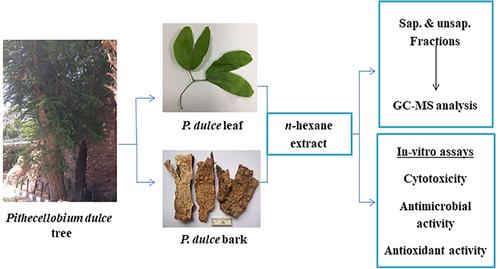当前位置:
X-MOL 学术
›
Chem. Biodivers.
›
论文详情
Our official English website, www.x-mol.net, welcomes your
feedback! (Note: you will need to create a separate account there.)
Profiling the lipophilic fractions of Pithecellobium dulce bark and leaves using GC/MS and evaluation of their antioxidant, antimicrobial and cytotoxic activities
Chemistry & Biodiversity ( IF 2.3 ) Pub Date : 2020-06-30 , DOI: 10.1002/cbdv.202000048 Sara Saeed Kotb 1 , Iriny M Ayoub 2 , Safaa A El-Moghazy 1 , Abdel Nasser B Singab 2, 3
Chemistry & Biodiversity ( IF 2.3 ) Pub Date : 2020-06-30 , DOI: 10.1002/cbdv.202000048 Sara Saeed Kotb 1 , Iriny M Ayoub 2 , Safaa A El-Moghazy 1 , Abdel Nasser B Singab 2, 3
Affiliation

|
Pithecellobium dulce has been used in traditional medicine to treat various ailments owing to its restorative properties. The biological activities and chemical profiles of the lipophilic fraction of P. dulce bark and leaves were assessed herein. Fatty acid methyl esters (FAME) and unsaponifiable matter (USM) were prepared and analyzed by GC/MS. A total of 40 compounds were identified in the bark saponifiable fraction, whereas 9 compounds were annotated in the leaves. Palmitic acid methyl ester was the major compound identified accounting for 41.48 % of the bark and 19.03 % of the leaves composition. Besides, linolenic acid methyl ester (22.40 %) and linoleic acid (12.69 %) were annotated in the leaves saponifiable fraction. A total of 63 compounds were detected in the bark USM and 4 compounds were identified in the leaves. Phytol represented the major component in the leaves (52.57 %) followed by lupeol (20.68 %) and lupenone (8.60 %). Meanwhile, n‐dodecane dominated in the bark USM accounting for 24.69 % of the total composition. The leaves and bark lipophilic fractions revealed moderate antioxidant and antibacterial activities. Both extracts showed no antifungal activity. No cytotoxicity was observed for both lipophilic fractions. P. dulce offers a good source of antioxidant compounds that can be introduced to food and pharmaceutical industry.
更新日期:2020-06-30









































 京公网安备 11010802027423号
京公网安备 11010802027423号